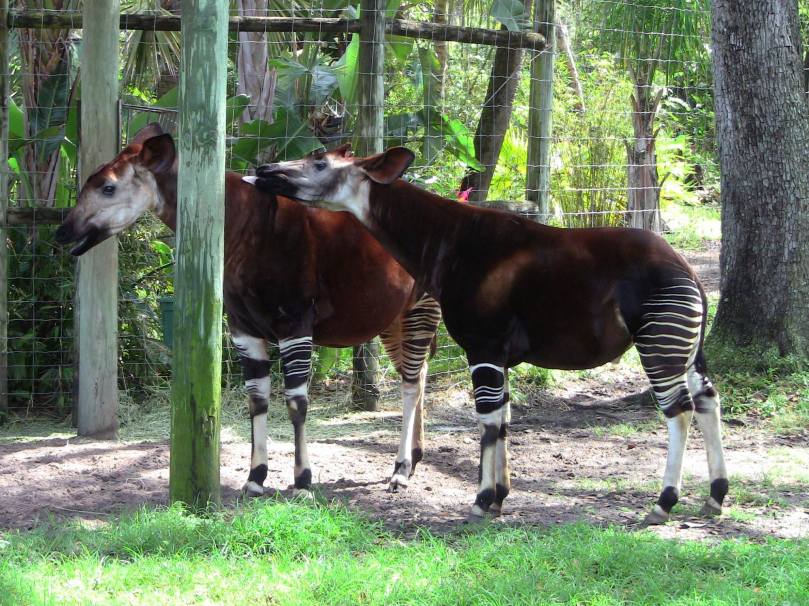Originally published at Bizarre Zoology on December 20, 2016
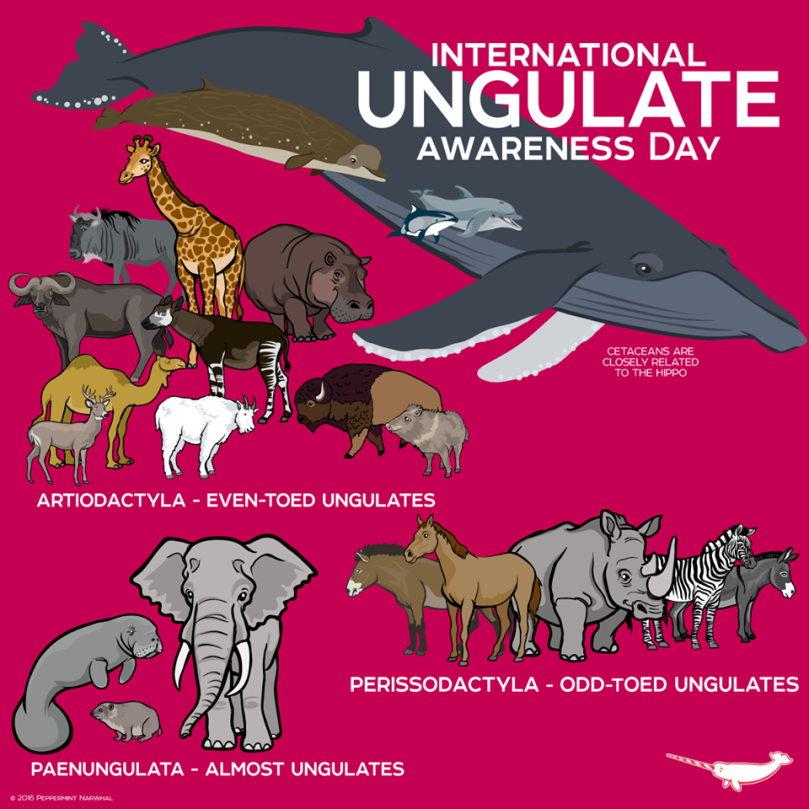
June 6 was International Ungulate Day, and numerous preoccupations have made me very late to finishing what was supposed to be timely recognition of a notable zoological holiday (many zoos and conservation foundations commemorate this day, so no I’m not just making it up). Since then, it has remained in the static position of a draft which has been somewhat nagging to me. I also began to expand this post in an unexpected direction, to the extent that I feel it necessary to split into two articles, with the forthcoming one being a musing on conservation at a time of dietary shift. This first article acts as a sort of homage to hoofed mammal lineages across the globe, in which I share some personal photographs and lesser known information that I’ve come across.
Spanning from a childhood obsession with cattle to the many hours my family and I have spent observing elk, ungulates have played an integral role in my life and have often been the primary source from which I gained an appreciation for biodiversity. While many belittle ungulates as boring, placid animals that do little more than graze and provide meals for carnivores, those who work and live with these animals can attest to their charismatic nature and profound ecological importance. I suspect that the aforementioned perspective is one founded in an anthropocentric lack of concern for these animals, as they provided more fuel than competition or danger to our species’ expansion. The diversity of the ungulates is tremendous: from tiny duikers slinking cryptically through deep African bush, to massive and culturally distinct orcas coursing through the water as they strategically hunt their prey. I must note that the term ‘ungulate’ seems to have largely fallen out of use in the scientific literature, with some specialists now considering it to merely function as a form taxon or folk taxon rather than a technical grouping. Referring to cetartiodactyls, perissodactyls, and paenungulates is more proper but, for the sake of International *Ungulate* Day, we can let it slide for now.
Some of the Ungulates I’ve Met
I figured that with all of my praise of how interesting this clade is, I might as well share some photographs of hoofed mammals I’ve had the privilege of observing during my own zoological endeavors. This gives me a chance to cover some of the fascinating details of ungulate anatomy, behavior, and ecology that rarely receives popular attention, although time constraints will limit the bulk of my writing for now. I will readily acknowledge that I am far from a prolific wildlife photographer, but I feel that even these act as crucial mementos to our planet’s biodiversity and I hope to gain better skills and equipment in the future.
First off are some American bison (Bison bison) I photographed during my most recent trip to Yellowstone National Park in 2014. Bison are the largest extant land mammal in North America, and have recently been christened as the national mammal of the United States. These bovines have shared a fascinating albeit troubled history with humans, and it is thought that the first encounter between a bison and a European person was Hernán Cortés’ 1521 observation of an individual living in the personal menagerie of Moctezuma II (Prothero & Schoch 2002). Interestingly, bison have been documented exhibiting homosexual behaviors like same-sex mounting, occuring more frequently in males than females and sometimes with the same frequency as heterosexual mounting (Sommer & Vasey 2006). While the impressive aura of a herd of bison makes them quite the spectacle to observe, respect of these dangerous animals is key, especially considering recent incidents involving tourists. The revival of bison represents one of the greatest success stories of mammalian conservation, and their future persistence may gain footing in a unique environmental movement…more on this in the second article of this series.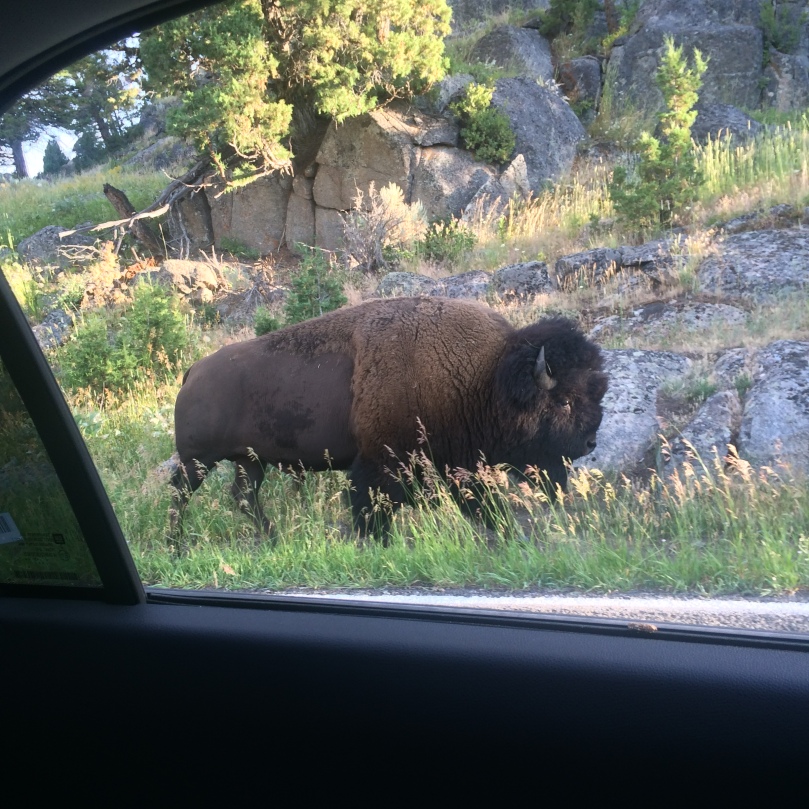
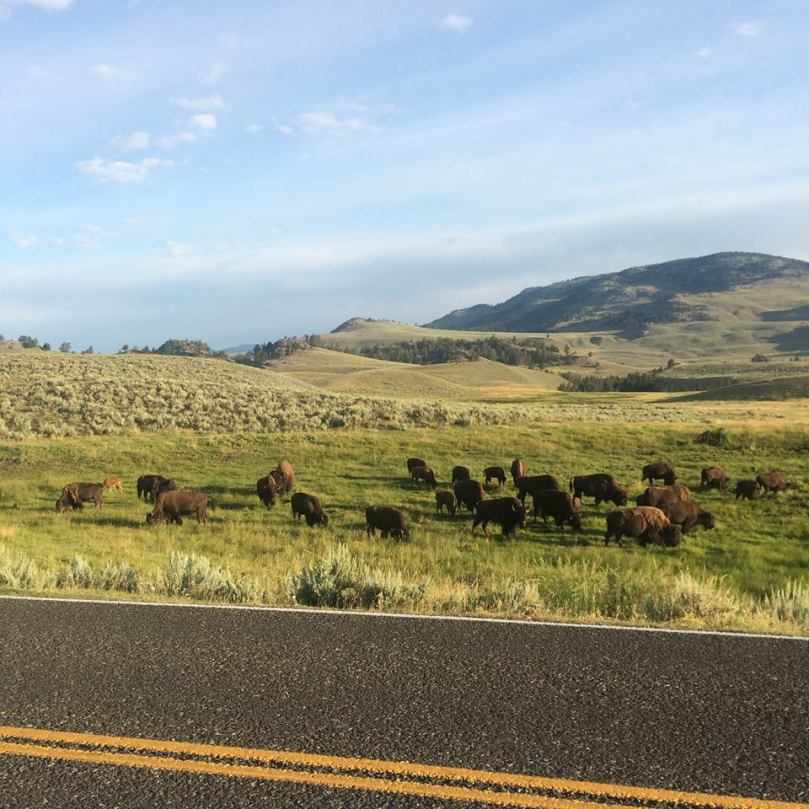 Next is a Scandanavian reindeer (Rangifer tarandus) bull photographed at the Buffalo Zoo, which is coincidentally only a few blocks away from where I attend college. Probably as a result of their non-territorial, precocial, socially gregarious, and environmentally-flexible disposition, reindeer are the only deer species to be widely domesticated (Prothero & Schoch 2002). Large-mammal ethologist Dr. Valerius Geist (2003) suggests that the reindeer was the most crucial prey species for sustaining and sparking the cultural flowering of Upper Paleolithic Homo sapiens of Europe, and that the latter people’s ability to intercept the migratory movements of the deer using lunar calendars gave them an edge in outcompeting the Neanderthals. It is thought that, after the extinction of Pleistocene glacial megafauna, modern humans were forced to adopt year-round stalking of reindeer and eventually translated this interaction into domestication by directing the herds’ movements into habitats suitable for exploitation (Geist 1998). Geist (1998) describes the reindeer as adapted to endure extremes in glacial environments, resulting in its having evolved into a ‘grotesque giant’ and the most cursorially adapted of extant deer species. With their morphology shaped by such life strategies, reindeer possess an ornate pelt, long neck beard, large fat deposits, the largest antlers of any modern deer species, and a body size which ranks them as the second largest New World deer (Geist 1998). Antlers are also possessed by females of the species due to competition with young male herd members for forage in their open plains niche (Geist 1998). Reindeer occasionally supplement their diet with animal matter such as lemmings, dead fish, bird droppings, human sweat, and dog urine, and have been observed consuming hallucinogenic mushrooms which may result in intoxication (Geist 1998).
Next is a Scandanavian reindeer (Rangifer tarandus) bull photographed at the Buffalo Zoo, which is coincidentally only a few blocks away from where I attend college. Probably as a result of their non-territorial, precocial, socially gregarious, and environmentally-flexible disposition, reindeer are the only deer species to be widely domesticated (Prothero & Schoch 2002). Large-mammal ethologist Dr. Valerius Geist (2003) suggests that the reindeer was the most crucial prey species for sustaining and sparking the cultural flowering of Upper Paleolithic Homo sapiens of Europe, and that the latter people’s ability to intercept the migratory movements of the deer using lunar calendars gave them an edge in outcompeting the Neanderthals. It is thought that, after the extinction of Pleistocene glacial megafauna, modern humans were forced to adopt year-round stalking of reindeer and eventually translated this interaction into domestication by directing the herds’ movements into habitats suitable for exploitation (Geist 1998). Geist (1998) describes the reindeer as adapted to endure extremes in glacial environments, resulting in its having evolved into a ‘grotesque giant’ and the most cursorially adapted of extant deer species. With their morphology shaped by such life strategies, reindeer possess an ornate pelt, long neck beard, large fat deposits, the largest antlers of any modern deer species, and a body size which ranks them as the second largest New World deer (Geist 1998). Antlers are also possessed by females of the species due to competition with young male herd members for forage in their open plains niche (Geist 1998). Reindeer occasionally supplement their diet with animal matter such as lemmings, dead fish, bird droppings, human sweat, and dog urine, and have been observed consuming hallucinogenic mushrooms which may result in intoxication (Geist 1998).
With reindeer being crucial to many human cultures, providing important services to their biotic communities, and revealing much about the evolution of Pleistocene fauna through their natural history, conservationists are distressed due to the impact of climate change on their ecology and population health. As revealed by zooarcheologists working in the Grotte XVI deposits of southwestern France, two separate warming periods which increased summer temperatures around 130,000 years go and 10,000 years ago sent local reindeer populations living in higher elevations into extinction (Schwarz 2004). Anthropogenic climate change is resulting in the reduction of lichen-rich environments fundamental for the cervids’ survival (Yannic et al. 2013), the phenological desynchronization of the breeding season and vital spring plant growth which calves rely on (Kerby & Post 2013), and an increased abundance of pest insects which disrupt their normal behavior (Culler et al. 2015). As mentioned before, Arctic cultures like the Sami people whose very livelihoods depend on the persistence of reindeer are suffering due to the strain on the population by a changing global climate (UNESCO 2012). Thus the great irony of the climate crisis which compels individuals like myself to highlight the matter: while politicians and other denialists decry any effort to address climate change by belittling it as a myth contrived to accrue scientific grants or alter business competition, the pleas of indigenous peoples who have no stake in perpetuating a lie are silenced. As the conservation of vulnerable Arctic ecosystems moves forward, it may be crucial to remember Valerius Geist’s (2003) profound statement that, “Modern humans owe much of what they are to reindeer. We need to reciprocate.”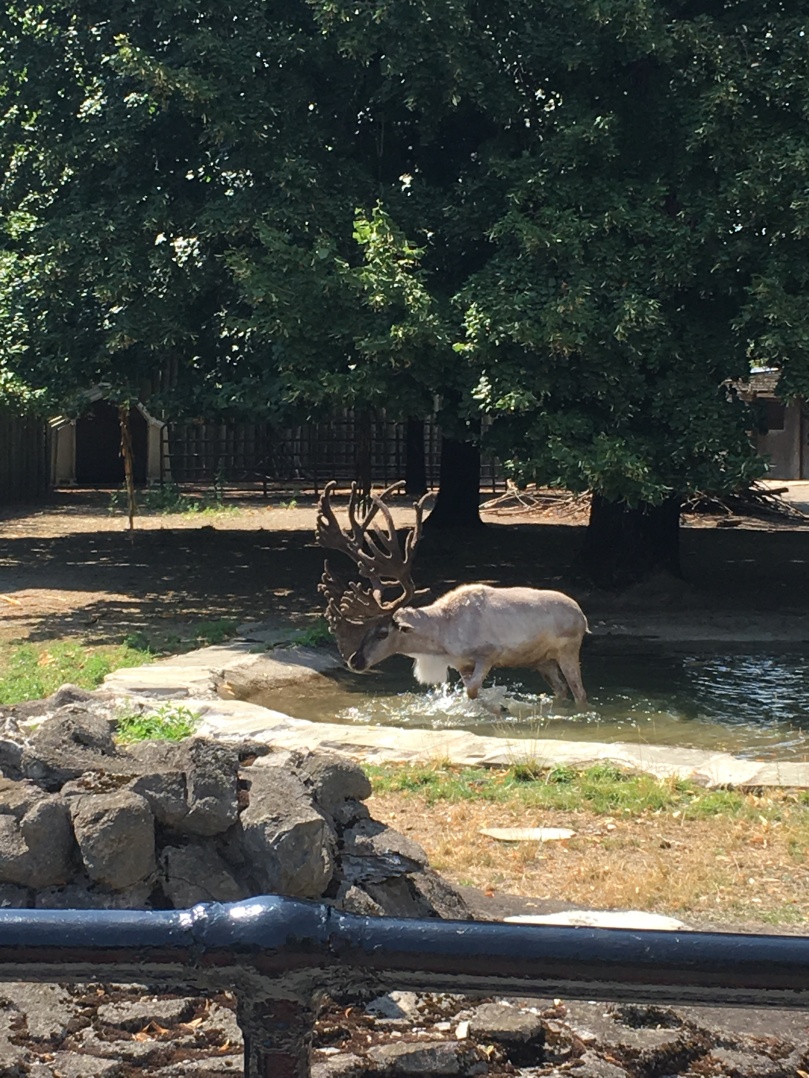 The Buffalo Zoo is home to a sizable group of Rocky Mountain bighorn sheep (Ovis canadensis canadensis). Due to their characteristic rutting clashes (which, according to Naish 2007, have been recorded as lasting over twenty-five hours), handsome curled horns, and bold demeanor, these are perhaps the best known of North America’s wild sheep. The Rocky Mountain bighorn sheep range across the cooler mountain ranges of Canada and the United States where they migrate within marked home ranges in correlation with the spread of seasonal vegetation (Prothero & Schoch 2002). The elastic pads on their feet provide shock absorption and traction, allowing them to ascend narrow canyon walls and plunge from 150-foot cliffs with few known accidents (Prothero & Schoch 2002). Some bighorn sheep populations have been documented exhibiting homosexual courtship and mating behaviors, with courting males using the same fixed suite of gestures and postures as they would in male-female pairs (Naish 2007). In an interesting yet unfortunate episode of first contact between fauna belonging to the same genus but having evolved in geographically disparate environments, the arrival of domestic sheep to the American west plagued Rocky Mountain bighorn populations with respiratory-tract diseases (Wild Sheep Foundation 2016). Studies indicate that between seventy-five to one-hundred percent of the members of a bighorn herd will succomb to illness after first contact with domestic sheep (Wildlife Sheep Foundation 2016), and wildlife conservation agencies are making fervent attempts to minimize interaction between the two species.
The Buffalo Zoo is home to a sizable group of Rocky Mountain bighorn sheep (Ovis canadensis canadensis). Due to their characteristic rutting clashes (which, according to Naish 2007, have been recorded as lasting over twenty-five hours), handsome curled horns, and bold demeanor, these are perhaps the best known of North America’s wild sheep. The Rocky Mountain bighorn sheep range across the cooler mountain ranges of Canada and the United States where they migrate within marked home ranges in correlation with the spread of seasonal vegetation (Prothero & Schoch 2002). The elastic pads on their feet provide shock absorption and traction, allowing them to ascend narrow canyon walls and plunge from 150-foot cliffs with few known accidents (Prothero & Schoch 2002). Some bighorn sheep populations have been documented exhibiting homosexual courtship and mating behaviors, with courting males using the same fixed suite of gestures and postures as they would in male-female pairs (Naish 2007). In an interesting yet unfortunate episode of first contact between fauna belonging to the same genus but having evolved in geographically disparate environments, the arrival of domestic sheep to the American west plagued Rocky Mountain bighorn populations with respiratory-tract diseases (Wild Sheep Foundation 2016). Studies indicate that between seventy-five to one-hundred percent of the members of a bighorn herd will succomb to illness after first contact with domestic sheep (Wildlife Sheep Foundation 2016), and wildlife conservation agencies are making fervent attempts to minimize interaction between the two species. On a recent visit to the Erie Zoo, the local zoo at which I am currently employed, I was very excited to find that it has acquired a Visayan warty pig individual (Sus cebifrons). The Visayan warty pig is a critically-endangered and rather cryptic mammal which has only recently been recognized as a distinct species (Braasch & Meijaard 2011). Native to the West Visayan Islands of the central Philippines, the Visayan warty pig is possibly the most primitive member of the genus Sus (Braasch & Meijaard 2011). Little is known about the behavior of these animals outside of captivity, although wild groups have been found to live in small social groups which are primarily active at night (Braasch & Meijaard 2011). Captive individuals have been described as “playful and friendly” (Braasch & Meijaard 2011), which is quite like how I would describe the response of this inquisitive individual who walked right up to the fence while grunting upon my arrival. These animals are apparently adept at clearing obstacles as, during an attempted capture of a juvenile female, the animal was observed to leap over a meter-high fence (Huffman 2013). Both males and females possess the distinctive mane running along the dorsal surface of their body and sometimes flopping over the face, although it is significantly longer in males during the breeding season (Braasch & Meijaard 2011). The scant data about the ecology of the Visayan warty pig suggests that they are crucial in the dispersal of certain plant seeds (Huffman 2013). Unfortunately, considering this important role in ecosystem services, the Visayan warty pig is under heavy threat from habitat destruction, persecutive hunting, and contact with domestic pigs which pollute their gene pool through hybridization and introduced pathogens (Huffman 2013).
On a recent visit to the Erie Zoo, the local zoo at which I am currently employed, I was very excited to find that it has acquired a Visayan warty pig individual (Sus cebifrons). The Visayan warty pig is a critically-endangered and rather cryptic mammal which has only recently been recognized as a distinct species (Braasch & Meijaard 2011). Native to the West Visayan Islands of the central Philippines, the Visayan warty pig is possibly the most primitive member of the genus Sus (Braasch & Meijaard 2011). Little is known about the behavior of these animals outside of captivity, although wild groups have been found to live in small social groups which are primarily active at night (Braasch & Meijaard 2011). Captive individuals have been described as “playful and friendly” (Braasch & Meijaard 2011), which is quite like how I would describe the response of this inquisitive individual who walked right up to the fence while grunting upon my arrival. These animals are apparently adept at clearing obstacles as, during an attempted capture of a juvenile female, the animal was observed to leap over a meter-high fence (Huffman 2013). Both males and females possess the distinctive mane running along the dorsal surface of their body and sometimes flopping over the face, although it is significantly longer in males during the breeding season (Braasch & Meijaard 2011). The scant data about the ecology of the Visayan warty pig suggests that they are crucial in the dispersal of certain plant seeds (Huffman 2013). Unfortunately, considering this important role in ecosystem services, the Visayan warty pig is under heavy threat from habitat destruction, persecutive hunting, and contact with domestic pigs which pollute their gene pool through hybridization and introduced pathogens (Huffman 2013).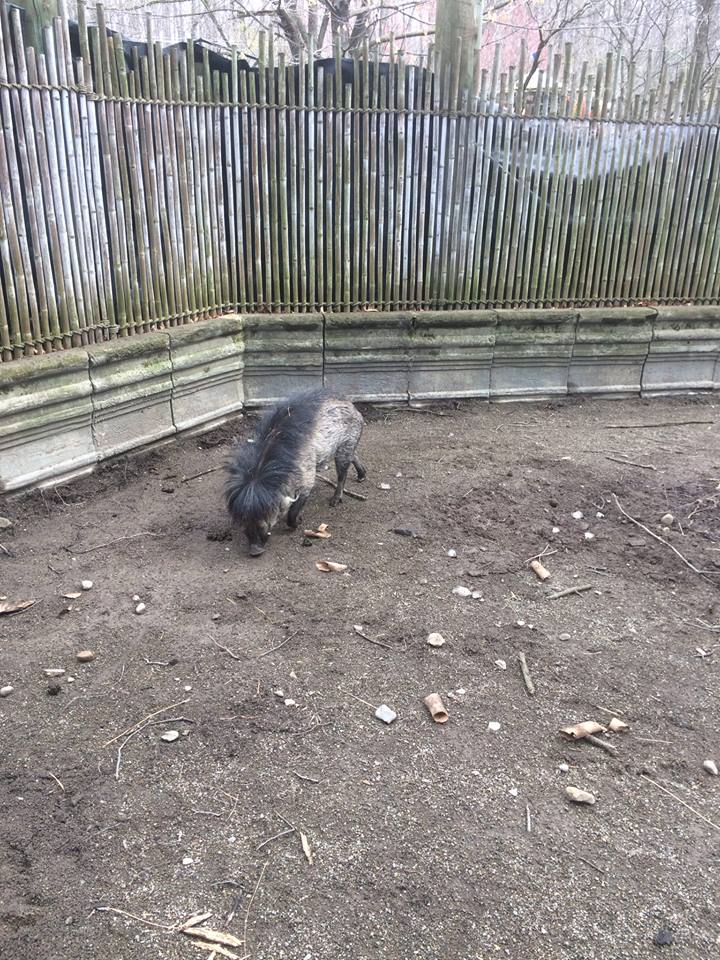 With the deer species of the world having always held the title of ‘my favorite animals’, I feel the need to boast that the Erie Zoo houses one of the most remarkable cervids: Père David’s deer (Cervus or Elaphurus davidianus). This marsh-dwelling deer is extinct in the wild largely as a result of hunting for its valuable antlers, which apparently once served a role as the medium for carved artwork and as substitutes for ivory (Wendt 1959). Despite this near loss, the Père David’s deer remains as a tribute to one of the most surreal stories of historical conservation. Herbert Wendt’s fantastic 1959 book Out of Noah’s Ark, an invaluable resource on anthrozoology of antiquity and pre-Heuvelmans cryptozoology, provides an excellent overview of this deer’s discovery by the Western world and the bizarre circumstances which led to its brush with extinction. The European discoverer of this species was a French Catholic priest and zoologist named Father Armand David who first beheld a herd of these animals after peering over the wall surrounding the heavily guarded Nan Hai-tsu game park in 1865 (Wendt 1959). After around a dozen Père David’s deer individuals were transported to European zoos during the remaining 1800s, tragedy struck the deer’s homeland of Nan Hai-tsu park in the form of the Hun-Ho river flood of 1895 and the Boxer Rebellion of 1900, leaving the original population to a fate of drowning and consumption by starving civilians and European troops (Wendt 1959). The Chinese game park was the last native refuge for this species, and the remaining Père David’s deer held in European captivity died as a result of faulty breeding programs (Wendt 1959). The extraordinary deer would have been lost to history if it were not for the eighteen individuals kept in secret by the Duke of Bedford at his estate of Woburn Abbey (Wendt 1959), from which numerous individuals have since been dispersed to other zoos and wildlife reserves in China where they have multiplied in the refuge of captivity.
With the deer species of the world having always held the title of ‘my favorite animals’, I feel the need to boast that the Erie Zoo houses one of the most remarkable cervids: Père David’s deer (Cervus or Elaphurus davidianus). This marsh-dwelling deer is extinct in the wild largely as a result of hunting for its valuable antlers, which apparently once served a role as the medium for carved artwork and as substitutes for ivory (Wendt 1959). Despite this near loss, the Père David’s deer remains as a tribute to one of the most surreal stories of historical conservation. Herbert Wendt’s fantastic 1959 book Out of Noah’s Ark, an invaluable resource on anthrozoology of antiquity and pre-Heuvelmans cryptozoology, provides an excellent overview of this deer’s discovery by the Western world and the bizarre circumstances which led to its brush with extinction. The European discoverer of this species was a French Catholic priest and zoologist named Father Armand David who first beheld a herd of these animals after peering over the wall surrounding the heavily guarded Nan Hai-tsu game park in 1865 (Wendt 1959). After around a dozen Père David’s deer individuals were transported to European zoos during the remaining 1800s, tragedy struck the deer’s homeland of Nan Hai-tsu park in the form of the Hun-Ho river flood of 1895 and the Boxer Rebellion of 1900, leaving the original population to a fate of drowning and consumption by starving civilians and European troops (Wendt 1959). The Chinese game park was the last native refuge for this species, and the remaining Père David’s deer held in European captivity died as a result of faulty breeding programs (Wendt 1959). The extraordinary deer would have been lost to history if it were not for the eighteen individuals kept in secret by the Duke of Bedford at his estate of Woburn Abbey (Wendt 1959), from which numerous individuals have since been dispersed to other zoos and wildlife reserves in China where they have multiplied in the refuge of captivity.
Apart from being peculiar for possessing the longest tail of any deer, retaining large canines used in fighting, exhibiting bipedal combat behavior, dropping their antlers twice a year, and frequently adorning their antlers with mud and vegetation (Naish 2011), Père David’s deer is one of the species that undermines the classic biological species concept. Not only do these deer successfully produce viable offspring with red deer, but its mosaic of primitive and advanced Cervus lineage traits has led to the suggestion that Père David’s deer arose as a result of a hybridization event (Naish 2011). Multiple authors of technical papers exploring Père David’s deer phylogeny have proposed that the animal speciated when a maternal parent similar to Eld’s deer mated with a paternal parent similar to wapati during the late Pliocene in China (Naish 2011). If you think this hypothesis is radical, don’t forget that work has recently revealed that our own species Homo sapiens sapiens has received genetic admixture from at least three contemporary hominin lineages.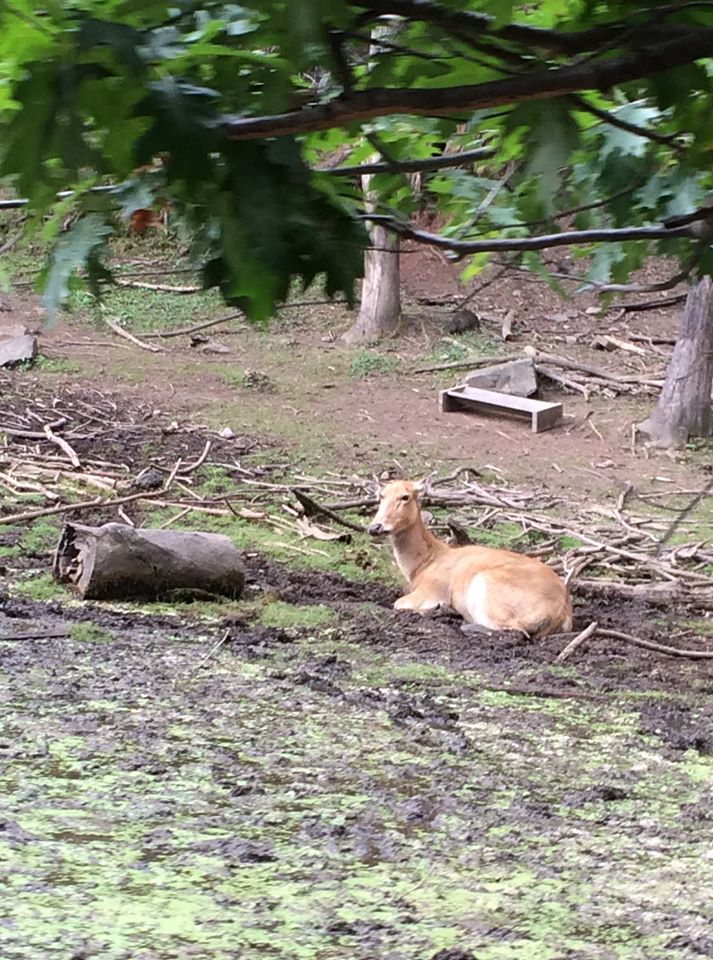 The okapi (Okapia johnstoni) will forever hold a place in my memory for being perhaps the most striking animal I have ever seen, both in its beauty and peculiarity. The photograph below shows two individuals allogrooming at the Jacksonville zoo. With cryptozoology having been at the forefront of my zoological interests in years past, I was first introduced to the okapi as being a success story of the kind of ethnoknowledge-based investigation that many leading minds in the field argue is its core methodology. As the signs of its existence grew, the zoologists on the track of the okapi variously interpreted it as a forest-dwelling zebra dubbed Equus johnstoni, an extant Hipparion, a relict Helladotherium, then finally a primitive genus of giraffid resembling Samotherium (Wendt 1959). After the captivating mammal was formally recognized by Western science in 1901, some art historians began to speak of a potential link between the identity of the totemic animal of the Egyptian god Set with the okapi and suggest that the Egyptians incorporated it into their mythology after encountering populations in the Upper Nile region (Wendt 1959).
The okapi (Okapia johnstoni) will forever hold a place in my memory for being perhaps the most striking animal I have ever seen, both in its beauty and peculiarity. The photograph below shows two individuals allogrooming at the Jacksonville zoo. With cryptozoology having been at the forefront of my zoological interests in years past, I was first introduced to the okapi as being a success story of the kind of ethnoknowledge-based investigation that many leading minds in the field argue is its core methodology. As the signs of its existence grew, the zoologists on the track of the okapi variously interpreted it as a forest-dwelling zebra dubbed Equus johnstoni, an extant Hipparion, a relict Helladotherium, then finally a primitive genus of giraffid resembling Samotherium (Wendt 1959). After the captivating mammal was formally recognized by Western science in 1901, some art historians began to speak of a potential link between the identity of the totemic animal of the Egyptian god Set with the okapi and suggest that the Egyptians incorporated it into their mythology after encountering populations in the Upper Nile region (Wendt 1959).
Okapis are largely diurnal and solitary mammals, although they occasionally form pairs or small family groups (Prothero & Schoch 2002). Geist (1998) describes their dark body coloration as characteristic of large mammals which engage in bold dominance displays for the purpose of predator confrontation and group defense of resources. Okapis are armed with short horns and possess dermal body armor for this purpose as well (Geist 1998), although combatting males also partake in ritualized neck fighting and females will kick potential predators of their young (Prothero & Schoch 2002). The white throat patch of the okapi is used as an agonistic display in courtship encounters, and some ethologists have proposed that the distinct white stripes on the hindquarters may serve a purpose in calf imprinting (Prothero & Schoch 2002). And, as a random closing note, has anyone else found themselves cringing at the number of zoogoers who refer to okapis as “that zebra-horse thing”?
The final ungulate photograph of this post is one of a probably unexpected nature: that of a humpback whale (Megaptera novaeangliae). This individual was photographed by my father during a whale-watching excursion in Booth Bay Harbor in 2006, and observing this massive animal spy-hop so near to the whale-watching vessel that we were on made an indelible mark on my memory. Although you surely know as a reader of this sort of blog, cetaceans are indeed members of Cetartiodactyla with a close evolutionary affiliation to modern hippos placing the two in the clade Whippomorpha. Many of their feeding, mating, parent-offspring interaction, and communication patterns can be traced across the phylogenetic tree to analogous behaviors exhibited by terrestrial artiodactyls (Würsig 1988). However, as whale-watchers can certainly attest to, cetaceans have also evolved a distinct array of behaviors fine-tuned to their marine ecology, many of which like the bubble-net and lobtail feeding techniques observed in humpback whales are spread socially as cultural traditions (De Waal 2016).
As discussed in the brilliant video How Whales Change the Climate and the revolutionary paper written by Roman & McCarthy (2010), the feces of large cetaceans like humpback whales provide the nutrients necessary for the growth of phytoplankton which not only establish the basis for marine food webs but absorb significant quantities of carbon dioxide from the atmosphere. Perhaps most significantly, these microorganisms are responsible for the production of half of the Earth’s breathable oxygen, but growing satellite imaging data suggest that the global concentration of marine phytoplankton is plummeting (Boyce et al. 2010). Thus, while the preservation of marine fauna has generally been thought of as yielding merely aesthetic benefits for humanity, the revival of cetacean populations may be pivotal to preventing a future impaired by a disastrously warming ocean and the need for global use of oxygen supplements. The discovery of ‘the whale pump’ may prove to be one of the most crucial findings for encouraging the conservation of marine ecosystems from such current crises as overfishing and shipping noise pollution. Such unnerving yet demanding thoughts aside, I may have the chance to travel to British Columbia to observe humpback whales this year, an opportunity which will hopefully act as a gateway for my own participation in the conservation of these awe-inspiring animals. While on the topic of cetaceans, I feel it appropriate to also note that I am currently an assistant on the Canisius Marineland research team studying beluga whales (Delphinapterus leucas), which has provided some unforgettable experiences and a taste of living my zoological dreams. Some of this group’s fascinating previous work can be found here.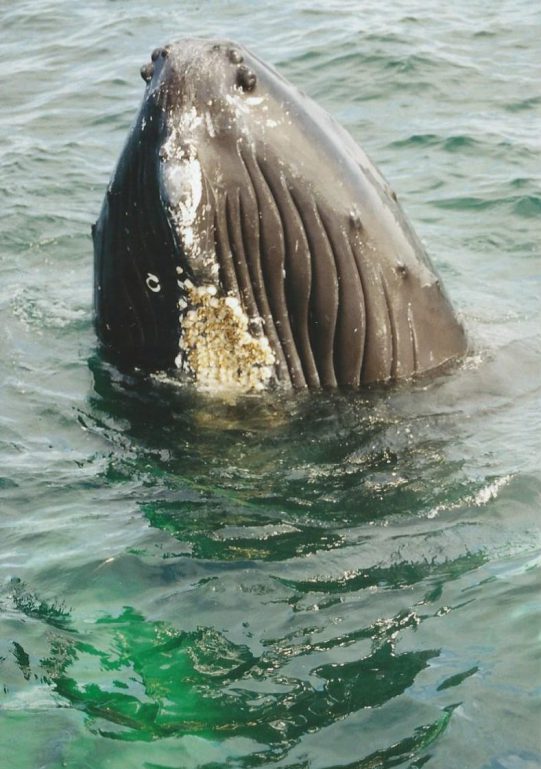
I’m hoping to publish the follow-up to this article in the near future, but for now, I hope that everyone has a wonderful week leading up to Christmas! Oh, and if anyone is looking for some last minute ungulate-related gifts, I must say that I recently had the chance to read José R. Castelló’s Bovids of the World and it is an exceptional resource on the impressive yet poorly known diversity of Bovidae. It contains an abundance of color photographs of these animals from multiple angles, the collection of which surely required exhaustive dedication, and is worth purchasing for this aspect alone!
References:
Boyce, Daniel G., Marlon R. Lewis, and Boris Worm. “Global Phytoplankton Decline over the past Century.” Nature 466.7306 (2010): 591-96. Nature.com. Web. 26 July 2016. http://www.nature.com/nature/journal/v466/n7306/pdf/nature09268.pdf.
Braasch, Thiemo, and Erik Meijaard. “Visayan Warty Pig (Sus Cebifrons).” Wild Pig Specialist Group. N.p., 2011. Web. 16 June 2016. https://sites.google.com/site/wildpigspecialistgroup/home/sus-cebifrons.
Culler, Lauren E., Matthew P. Ayres, and Ross A. Virginia. “In a Warmer Arctic, Mosquitoes Avoid Increased Mortality from Predators by Growing Faster.” Proceedings of the Royal Society B: Biological Sciences Proc. R. Soc. B 282.1815 (2015): 20151549. The Royal Society Publishing. Web. 13 July 2016. http://rspb.royalsocietypublishing.org/content/282/1815/20151549.
Geist, Valerius. Deer of the World: Their Evolution, Behaviour, and Ecology. Mechanicsburg, PA: Stackpole, 1998. Print.
Geist, Valerius. “Of Reindeer and Man, Modern and Neanderthal: A Creation Story Founded on a Historic Perspective on How to Conserve Wildlife, Woodland Caribou in Particular.” Ran Rangifer 23.5 (2003): 57. Septentrio Academic Publishing. Web. 08 Jun. 2016.
“Hiker Killed by Mountain Goat in Olympic Nat’l. Park.” Seattlepi.com. Hearst Seattle Media, 16 Oct. 2010. Web. 16 June 2016. http://www.seattlepi.com/local/article/Hiker-killed-by-mountain-goat-in-Olympic-Nat-l-887209.php.
Huffman, Brent. “Visayan Warty Pig (Sus Cebifrons).” Ultimate Ungulate. N.p., 20 Feb. 2013. Web. 17 June 2016. http://www.ultimateungulate.com/Artiodactyla/Sus_cebifrons.html.
Kerby, Jeffrey T., and Eric Post. “Advancing Plant Phenology and Reduced Herbivore Production in a Terrestrial System Associated with Sea Ice Decline.” Nature Communications 4 (2013): n. pag. Nature Communications. Web. 13 July 2016. http://www.nature.com/ncomms/2013/131001/ncomms3514/full/ncomms3514.html.
Naish, Darren. “The Seemingly Endless Weirdosity of the Milu.” Tetrapod Zoology. Scientific American Blog Network, 11 Oct. 2011. Web. 24 June 2016. http://blogs.scientificamerican.com/tetrapod-zoology/the-seemingly-endless-weirdosity-of-the-milu/
Prothero, Donald R., and Robert M. Schoch. Horns, Tusks, and Flippers: The Evolution of Hoofed Mammals. Baltimore: Johns Hopkins UP, 2002. Print.
Roman, Joe, and James J. Mccarthy. “The Whale Pump: Marine Mammals Enhance Primary Productivity in a Coastal Basin.” PLoS ONE 5.10 (2010): n. pag. PlosOne. Web. 13 July 2016. http://journals.plos.org/plosone/article?id=10.1371/journal.pone.0013255.
Schwarz, Joel. “Say Goodbye to Rudolph and Other Reindeer If Global Warming Continues.” UW Today. University of Washington, 1 Dec. 2004. Web. 11 July 2016. http://www.washington.edu/news/2004/12/01/say-goodbye-to-rudolph-and-other-reindeer-if-global-warming-continues/
Sommer, Volker, and Paul L. Vasey. Homosexual Behaviour in Animals: An Evolutionary Perspective. Cambridge: Cambridge UP, 2006. Print.
“On the Frontlines of Climate Change: Sami Reindeer Herders | United Nations Educational, Scientific and Cultural Organization.” United Nations Organization for Education, Science and Culture. UNESCO Natural Sciences Sector, 19 Dec. 2011. Web. 18 Aug. 2016. http://www.unesco.org/new/en/media-services/single-view/news/on_the_frontlines_of_climate_change_sami_reindeer_herders/#.V7YRWJXr0pv.
Wendt, Herbert. Out of Noah’s Ark: The Story of Man’s Discovery of the Animal Kingdom. Boston: Houghton Mifflin, 1959. Print.
“Wild Sheep – Domestic Sheep Disease Transmission.” Wild Sheep Foundation. Wild Sheep Foundation, 21 Mar. 2016. Web. 13 June 2016. http://www.wildsheepfoundation.org/Page.php/cp/Wild%20Sheep%20-%20Domesti.
Würsig, Bernd. “The Behavior of Baleen Whales.” Scientific American 258.4 (1988): n. pag. Web. https://drive.google.com/file/d/0B682wgTUA8QiREF0WDE3U2hIdDA/view
Yannic, Glenn, Loïc Pellissier, Joaquín Ortego, Nicolas Lecomte, Serge Couturier, Christine Cuyler, Christian Dussault, Kris J. Hundertmark, R. Justin Irvine, Deborah A. Jenkins, Leonid Kolpashikov, Karen Mager, Marco Musiani, Katherine L. Parker, Knut H. Røed, Taras Sipko, Skarphéðinn G. Þórisson, Byron V. Weckworth, Antoine Guisan, Louis Bernatchez, and Steeve D. Côté. “Genetic Diversity in Caribou Linked to past and Future Climate Change.” Nature Climate Change 4.2 (2013): 132-37. Nature Communications. Web. 14 July 2016. http://www.nature.com/nclimate/journal/v4/n2/full/nclimate2074.html.

